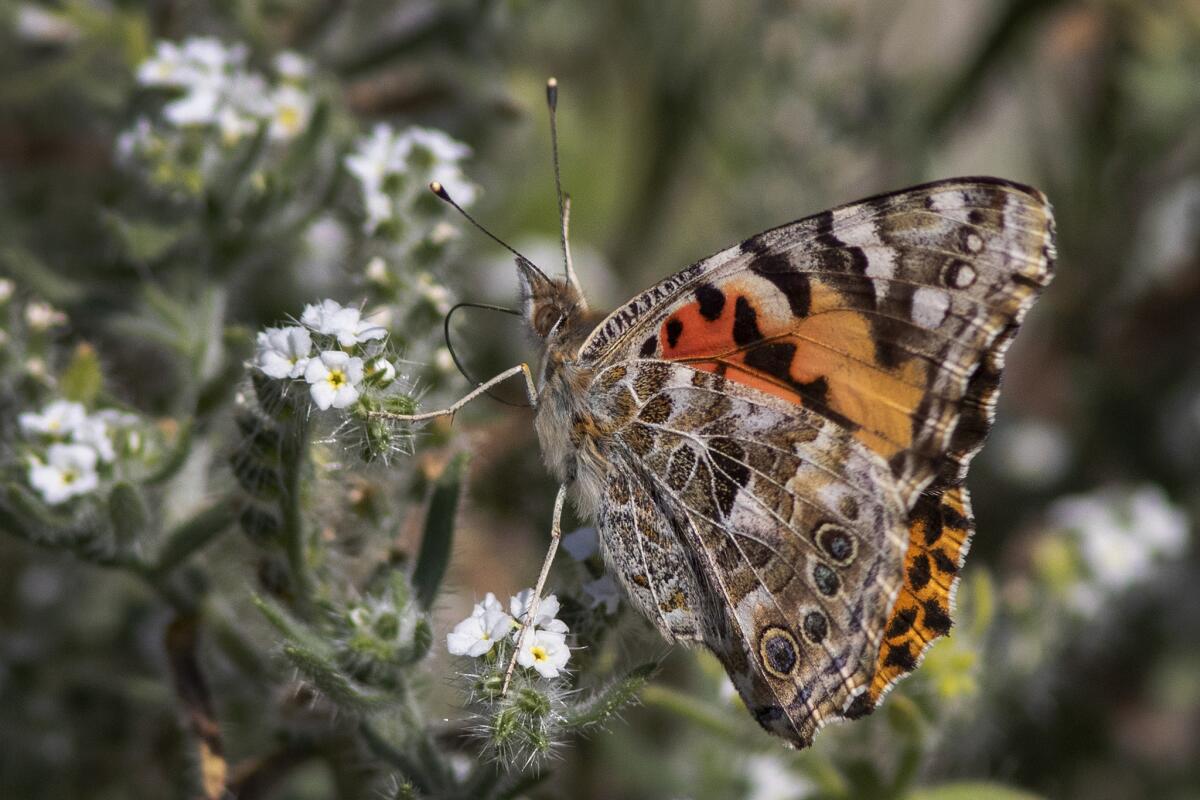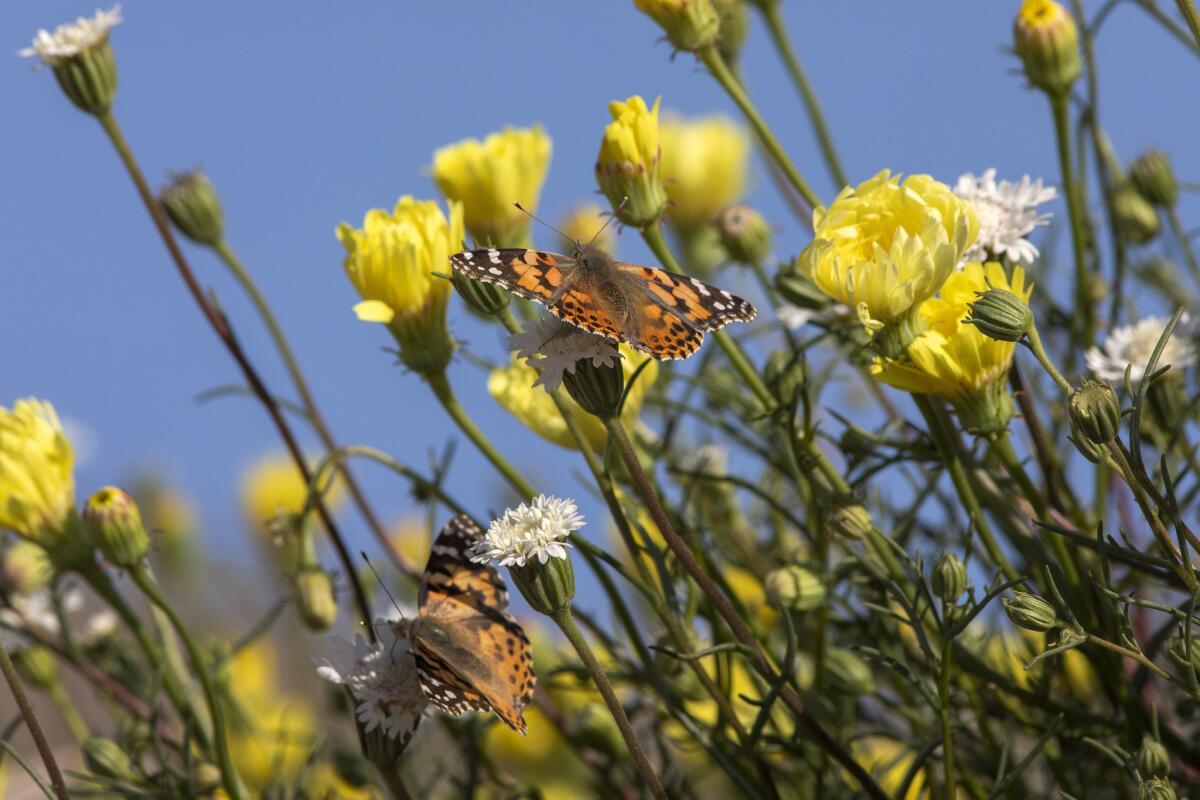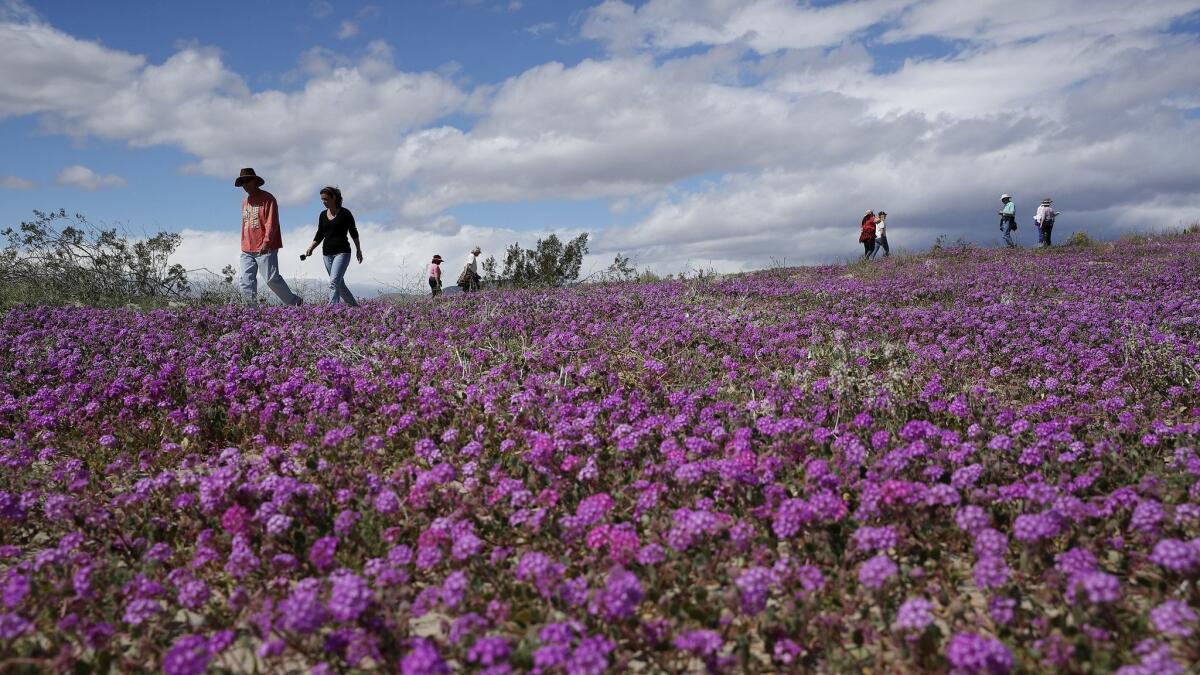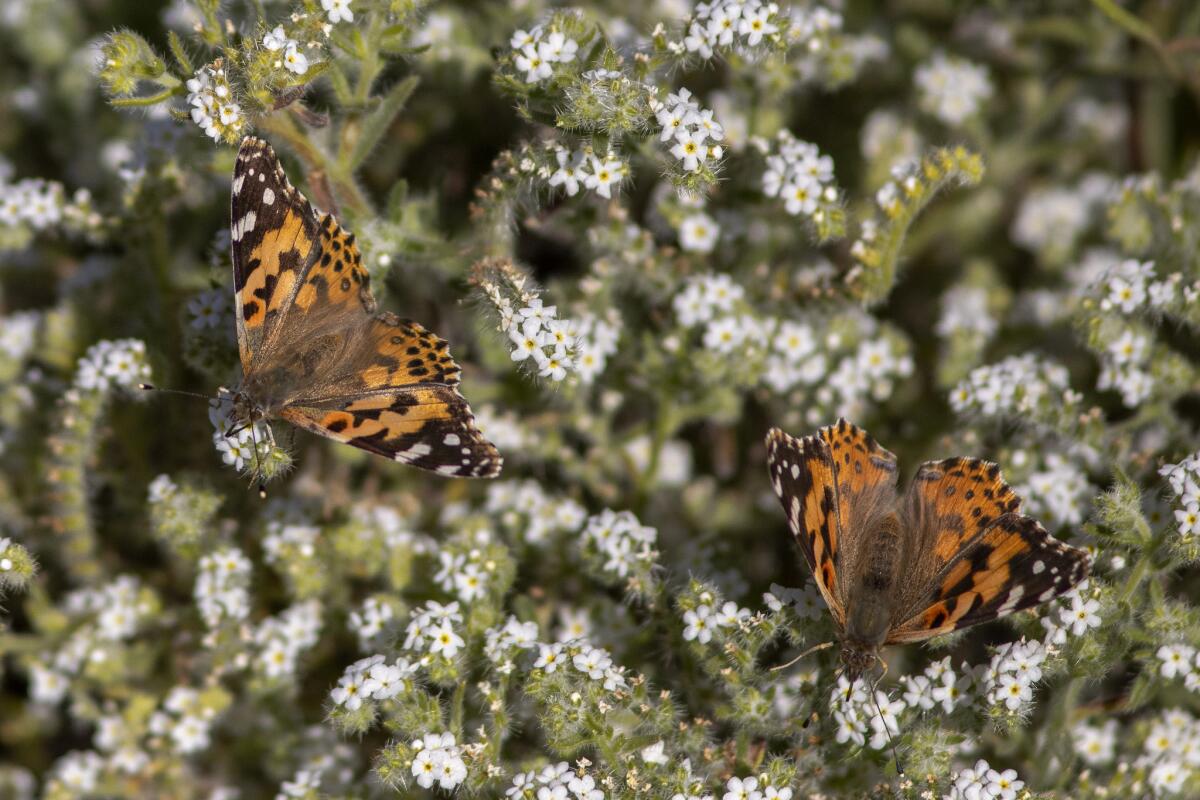Must Reads: In the middle of a butterfly crisis, California sees a burst of painted ladies

- Share via
Perhaps you spotted them on La Cienega, flitting north by the thousands near the Westfield mall.
Maybe you saw them in Santa Anita, crossing a quiet residential street in a thick, fluttering line.
For the record:
9:50 a.m. March 13, 2019An earlier version of this article said Art Shapiro had counted 25,200 Painted Ladies at 10 sites in 2018 and 315,997 a year earlier. The numbers are 27 and 512, respectively.
You may have even commuted with hundreds of them along the 105 Freeway, where they furiously flapped their small wings as if they were trying to catch a flight at Los Angeles International Airport.
Those black-and-orange insects that seem to be everywhere you look in Southern California aren’t monarchs and they aren’t moths. They are called painted ladies, and these butterflies are migrating by the millions across the state.
The migration itself is nothing new. Painted ladies set off from their wintering grounds in the Mojave and Colorado deserts of southeastern California as winter gives way to spring. They travel roughly the same path every year, flying northwest to Sacramento en route to Oregon, Washington and beyond. (They’ve been spotted as far north as Alaska.)
What’s unusual this year is the number of 2- to 3-inch butterflies making the journey. Scientists say there haven’t been this many painted ladies traversing the state since 2005, when the population climbed to about 1 billion.
“When they are scarce nobody notices them,” said Art Shapiro, an ecologist at UC Davis who has been tracking butterflies in the state for nearly 50 years. “When they are abundant, everyone notices.”
James Danoff-Burg, the conservation director at the Living Desert Zoo and Gardens in Palm Desert, encountered a pack of butterflies while riding a bike through La Quinta last week.
“They were flying parallel to me, just bobbing along as I rode past the date palms,” he said. “It was absolutely magical. I felt like a Disney princess.”

The painted lady explosion is a welcome exception to California’s current butterfly crisis. The number of butterflies in the state has been in decline for decades, reaching historic lows in 2018, according to research conducted by Shapiro and others.
“It was a terrible — perhaps even catastrophic — butterfly year at all elevations and no, we don’t know why,” Shapiro wrote in a somber report.
A monarch count led by the Xerces Society for Invertebrate Conservation in November found only 28,429 of the iconic orange-and-black insects wintering along the California coast. That figure represents an 85% drop from the previous year and a 99.4% plunge compared with 40 years ago.
“In our grove alone we would have 250,000 monarchs in the 1980s,” said Danielle Bronson, a state park interpreter at Pismo State Beach. “This season we had about 3,000 at our peak.”
Other butterfly populations have been hit even worse.
At least 20 species are disappearing faster than the monarch, said Matt Forister, an ecologist at the University of Nevada, Reno.
They include the large marble butterfly (Euchloe ausonides), the field crescent (Phyciodes campestris campestris), the west coast lady (Vanessa annabella), the common sooty wing (Pholisora catullus) and the California ringlet (Coenonympha tullia california).
“There are a lot of butterflies declining quite rapidly,” he said.
No one is certain what is causing butterflies in California to disappear, but researchers have identified several likely contributing factors.
They include the general loss of open spaces that mean fewer flowers and leaves for food, as well as changing agricultural practices that have reduced the number of butterfly-friendly plants along the edges of crop fields. The growing use of pesticides by farmers and home gardeners probably plays a role. So does climate change, which produces higher temperatures that can dry plants out and make them inedible.
“There is not one cause for the butterfly decline — that’s not how population extinction happens,” Forister said. “It’s more likely a suite of factors that are pushing on all these species.”
Even the painted ladies (Vanessa cardui) appeared to be suffering as recently as last year. In 2018, Shapiro counted just 27 of the butterflies at the 10 sites he monitors on a regular basis. A year earlier, that number was 512 .
Scientists say the reason for this year’s rebound can be summed up in one word: rain. And more specifically, rain in the desert.
“The more plants, the more butterflies,” Shapiro said. “So any year you have a real big bloom in the desert is potentially a big year for painted ladies.”

The life cycle of these hardy butterflies is still a bit fuzzy, but scientists believe that each winter the entire Western population retreats to the California desert to wait for the rains to come.
“Once it rains, and the plants start to germinate, they breed like crazy,” Shapiro said. “So where it rains is where they breed.”
This winter, the rains fell long and hard.
“The average annual rainfall in the Coachella Valley is 3 inches,” Danoff-Burg said. ”This year, we had 3½ inches on Valentine’s Day alone.”
Butterflies lay their eggs on plants so that the larvae will have something to eat after they hatch. All the rain produced an abundance of vegetation in the desert, which gave painted lady caterpillars plenty of food to munch on, scientists said.
As a result, far more caterpillars than usual were able to survive into adulthood.
“The conditions were perfect for them, so now we are seeing a lot of them coming out all at once,” said Doug Yanega, a scientist at the Entomology Research Museum at UC Riverside.
Even before the rains, painted ladies were not high on the list of butterfly species to fret about, Forister said. Vanessa cardui is the most abundant butterfly in the world and can be found on every continent except South America and Antarctica.
“They are a boom-bust species,” he said. “In some ways, they are the most successful butterflies on the planet.”
Among their many superpowers is the ability to eat a remarkably wide range of plants. Most butterfly species rely on only one or two plants. Think monarchs and milkweed: If the number of milkweed plants drops, the number of monarchs will drop as well.
Painted ladies generally stick to nettles, mallows and borages, but in a breakout year such as this, they will happily consume lupine, sunflowers and other types of plants.
“They are able to ingest an amazing diversity of plant toxins,” Forister said. “Most insects can’t do that.”
Unlike other species, they have the ability to shiver for warmth, allowing them to survive in cooler temperatures.
They’re also capable of flying great distances to find places to breed and lay their eggs. Scientists recently discovered that some painted ladies fly 2,500 miles across the Sahara each spring.
After the butterflies reach adulthood in the California deserts, in late winter or early spring, they disperse to the northwest, flying without stopping at speeds of up to 25 mph. The insects can travel 240 miles from Lone Pine in the Eastern Sierra to Davis in three days.
“They fly like a bat out of hell,” Shapiro said.
The migrating painted ladies are fueled by a packet of yellow abdominal fat, stored from their caterpillar days, that enables them to fly hundreds of miles without stopping. (That fat is responsible for the yellow streaks on your car windshield if you happen to run into one.) When the fat reserve runs out, they will stop and breed. The next generation will continue the trek north.

In the fall, the migration pattern reverses. But the southern journey is more leisurely. Without stored fat, the butterflies make more stops to drink nectar, and breed, along the way. They arrive in the desert in late fall and the cycle begins again.
Shapiro said Southern California’s painted lady deluge will not last long. In another week or two, the last of them will have departed for northern climes.
But this may not be the year’s last butterfly barrage thanks to the wet winter.
“Rain is good for everything,” Forister said. “We’ll see how far it takes us in the recovery.”
Do you love science? I do! Follow me @DeborahNetburn and “like” Los Angeles Times Science & Health on Facebook.
MORE IN SCIENCE







